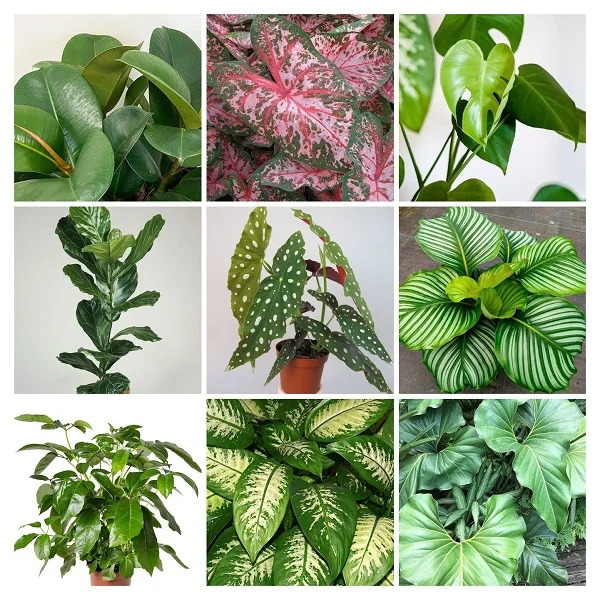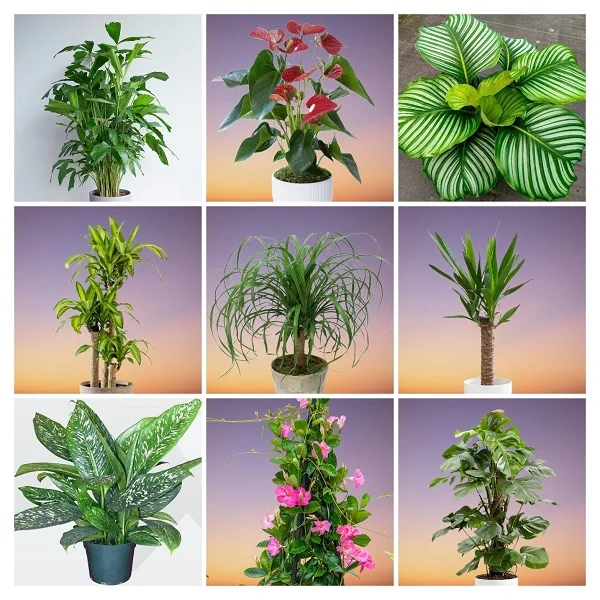30 Best Indoor Flowers for a Splash of Color in Your Home
Some links in this post may be affiliate links
Indoor flowering plants add a splash of color to brighten up any home. Flowers for indoors come in many forms and colors. Some are quite easy to grow while some may require special attention.
Flowering indoor plants require bright light to promote blooming. Consistent watering is also vital for these plants as it does affect flowering.
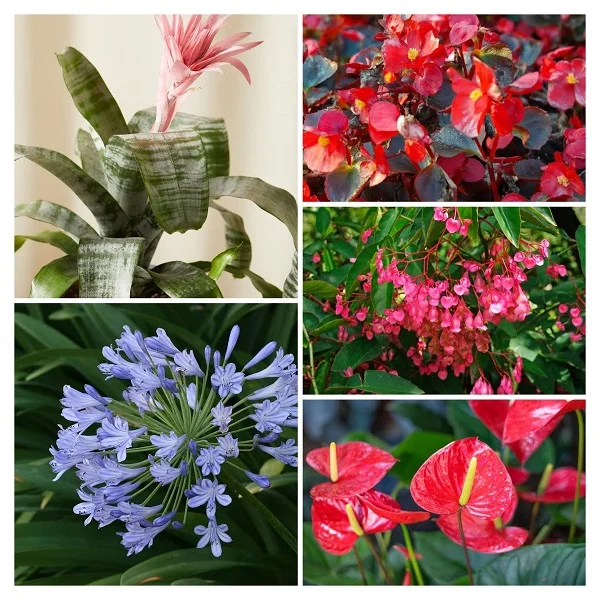
Most of the flowers for indoor growing have their origin in the tropics and will require warm and humid conditions to thrive and bloom.
Indoor flowers will benefit a great deal if they are given some outdoor sunshine in the warm season. However, do not expose them to direct sunlight before acclimating them to outdoor growing conditions.
We have herebelow outlined a list of 30 best flowering plants for indoors that you can grow without much trouble if you provide the right growing conditions.
30 Flowering Indoor Plants with Names & Pictures
Best indoor flowering plants are Angel Wing Begonia, Gerbera Daisy, Peace Lily, Fuchsia, Geraniums, Impatiens, Bird of Paradise, Orchids, Flame Violet, Cyclamens, Bush Lily, Flamingo Flower, Calathe crocata among others.
1. Angel Wing Begonia
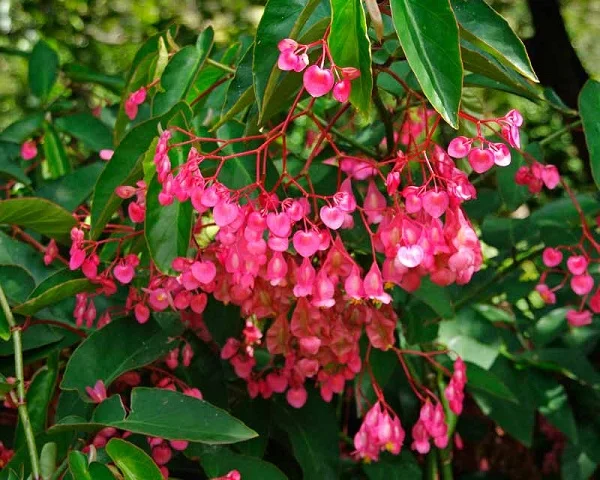
Botanical name: Begonia coccinea
Common name: Angel Wing Begonia, Scarlet Begonia
Origin: Atlantic Forest of Brazil, distributed in Rio de Janeiro and Espírito Santo
Height: 6-8 feet
Angel Wing Begonia also called Scarlet Begonia is one of the popular Begonia varieties and comes with large, glossy, red-margined leaves. The leaves are 'angel wing' shaped and hence the common name.
Scarlet Begonia is an evergreen, shrubby, flowering plant which bears large clusters of waxy flowers which hang from the stems beautifully. They come in red, white, orange and pink. Angel Wing Begonia like Begonia semperflorens (Wax Begonia) is one the best flowering plants for the home.
Begonia coccinea blossoms in bright indirect light (filtered light), warmth of 18-260C, humidity of 50-55% and consistently moist, rich, well-drained soil with weekly feeding in the growing season.
Learn more on how to grow and care for Angel Wing Begonia
2. Bird of Paradise Plant
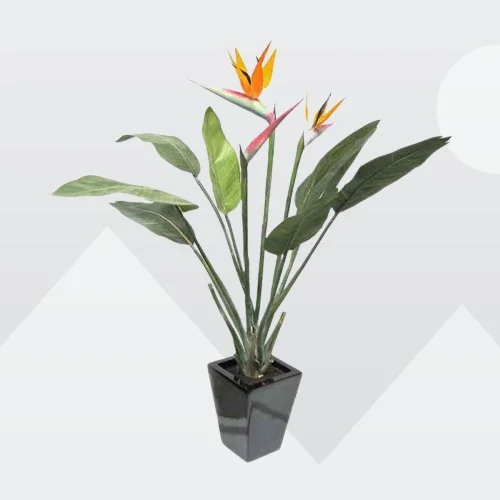
Botanical name: Strelitzia reginae
Common names: Bird of Paradise Plant, Crane Flower
Origin: South Africa
Height: 3-5 ft
Bird of Paradise Plant flowers fan out from the spathe, forming a crane bird-like crest. Each spathe will produce several flowers in succession.
Crane Flower grows to a height of about 5-7 feet and 3-4 feet wide. It is not as large as its relative White Bird of Paradise Plant (Strelitzia nicolai) which can grow to a height of about 20-30 feet and 6-10 feet wide.
Strelitzia reginae grows best in bright light with at least 4-6 hours of direct sunshine, warmth of 16-270C, humidity of 60-70% and consistently moist, fertile, well-drained potting soil coupled with monthly feeding during the growing season.
Learn more on how to grow and care for Bird of Paradise Plant
3. Bush Lily
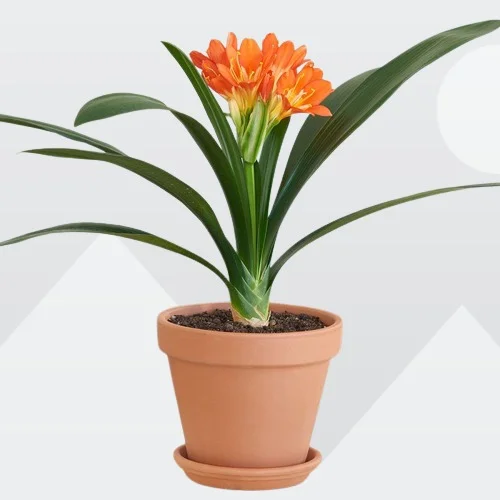
Botanical name: Clivia miniata
Common names: Bush Lily, Natal Lily
Origin: South Africa and Swaziland
Height: 1.5 ft
The flowers in Bush Lily are orange, red, cream and yellow, and may have a faint but very sweet perfume. The flowers occur in cluster of about 10-20 and are borne on top of a tall stalk.
Clivia miniata grows to a height of 18 inches. On account of its compact size and love for some direct sunshine, Bush Lily is one of the best plants for a sunny balcony.
Clivia miniata flourishes in bright light with 4-6 hours of direct sunlight, warmth of 16-280C , humidity of 50-55% and moderately moist, rich, well-drained potting mixes coupled with fortnightly feeding during the growing season.
Learn more on how to grow and care for Bush Lily
4. Busy Lizzie
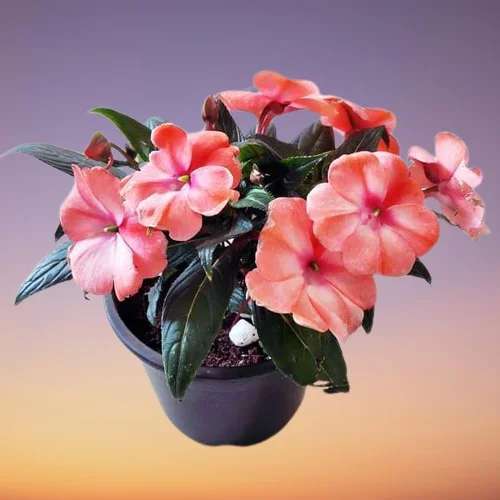
Botanical name: Impatiens wallerana
Common names: Busy Lizzie, Balsam, Sultana, Impatiens
Origin: Eastern Africa from Kenya to Mozambique
Height: 2 ft
The Impatiens wallerana group are popular flowering plants which include the green leaved Impatiens holstii and Impatiens sultani and the red-leaved Impatiens petersiana.
Balsam blooms are very attractive and will brighten up any space with their striking colors. They will bloom almost through out the year when given the proper care. Impatiens are some of the best plants for the front porch or entrance.
Impatiens wallerana prospers in bright indirect light, warmth of 15-240C, humidity of 60-70% and consistently moist, fertile, well-drained soil coupled with fortnightly feeding during the growing season.
Learn more on how to grow and care for Busy Lizzie
5. Cape Primrose

Botanical name: Streptocarpus hybrida
Common name: Cape Primrose
Origin: South Africa
Height: 1 ft
Cape Primrose bears trumpet-shaped flowers in white, blue, purple, pink and red with prominently-veined throats which hover or arch above the rosette of coarse, stemless strap-shaped 8-12 inches long leaves.
Cape Primrose like its relative African Violet (Saintpaulia ionantha), comes in various colors and forms but the old favorite Streptocarpus Constant Nymph with lilac flowers with violet veins remains the most popular.
Streptocarpus hybrida blossoms in bright indirect light, warmth of 18-250C, humidity of 60-70% and consistently moist, rich, well-drained soil accompanied by fortnightly feeding in the growing season.
Learn more on how to grow and care for Cape Primrose
6. Cyclamen
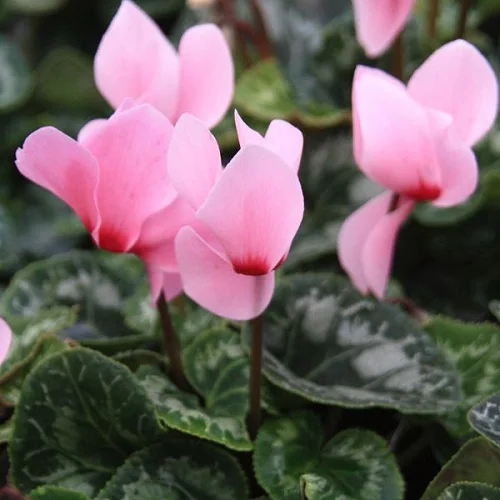
Botanical name: Cyclamen persicum
Common names: Cyclamen
Origin: North Africa, West Asia, Southeast Europe
Height: 1 ft
Cyclamen blooms from winter to spring. The flowers are usually white to pink with a band of deep-pink at the base and arise above the heart-shaped, fleshy, smooth-textured leaves with green-silvery, marbled surface on top and may be pale-green or reddish on the undersides.
Cyclamen is a popular, low-growing, compact, flowering plant and is among the best plants for limited spaces for instance a window sill, desktop, tabletop or plant shelf.
Cyclamen persicum blooms in bright indirect light (dappled light), temperatures of 10-180C, humidity of 70-80% and consistently moist, fertile, well-drained potting soil coupled with fortnightly feeding during the growing season.
Learn more on how to grow and care for Cyclamen persicum
7. Cigar Plant

Botanical name: Cuphea ignea
Common names: Cigar Plant, Cigar Flower, Mexican Cigar Plant
Origin: Mexico and West Indies
Height: 1 ft
Cigar Plant is a 1 ft, compact, flowering plant whose flowers come in a profusion, are tubular, cigar-shaped in orange, pink, purple, red, white and yellow.
Mexican Cigar Plant and Painted Nettle (Coleus blumei) are fast-growing plants and are perfect for limited spaces like a tabletop, desktop, plant shelf or windowsill.
Cuphea ignea flourishes in bright light with 4-6 hours of direct sunshine, warmth of 15-260C, humidity of 50-55% and moderately moist, fertile, well-drained soil coupled with fortnightly feeding in the growing season.
Learn more on how to grow and care for Cigar Plant
8. Eternal Flame Plant

Botanical name: Calathea crocata
Common names: Eternal Flame Plant, Saffron-coloured Calathea
Origin: Bahia and Espírito Santo states of eastern Brazil
Height: 1.5 ft
Calathea crocata also called Saffron-coloured Calathea is one of the popular Calathea varieties with colorful foliage and a display of erect orange-red flowers which come in summer and can last for 2-3 months.
Saffron-coloured Calathea is a small-sized, compact plant with magnificent, slightly wrinkled, metallic, dark-green leaves with purple to brown tones on the undersides and is perfect for an office space.
Calathea crocata thrives in bright indirect light with 4-6 hours of sunlight, warmth of 18-260C, humidity of 70-80% and moderately moist, fertile, well-drained soil coupled with monthly feeding during the growing season.
Learn more on how to grow and care for Eternal Flame Plant
9. Flame Violet
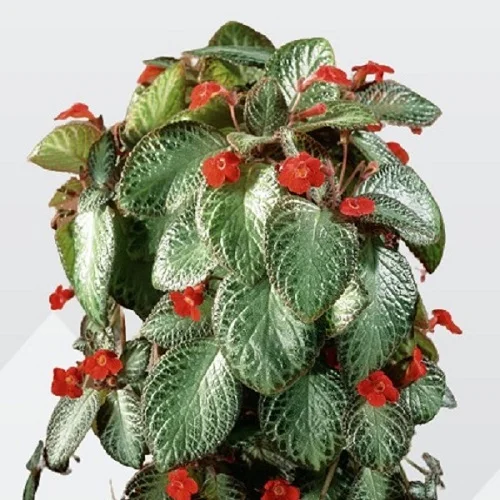
Botanical name: Episcia cupreata
Common name: Flame Violet
Origin: Brazil, Columbia, Venezuela
Height: 3-4 ft
Flame Violet is an eye-catching plant which is grown for its large leaves quilted with silvery or pale-green veins and tubular orange-red flowers which are yellow-eyed.
It may be difficult to grow as a stand alone plant or in a hanging basket. This is due to its requirement for highly humid conditions which places it among the popular plants for a bathroom, kitchen, laundry area and other moist areas in the home.
Episcia cupreata grows best in bright indirect light (filtered light), warmth of 15-270C, humidity of 60-70% and consistently moist, rich, well-drained African Violet potting mix coupled with fortnightly feeding during the growing season.
Learn more on how to grow and care for Flame Violet
10. Chinese Hibiscus
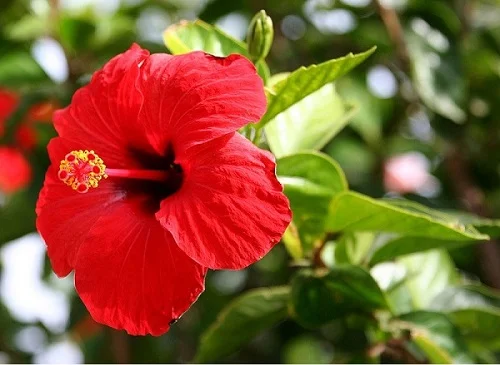
Botanical name: Hibiscus rosa-sinensis
Common names: Chinese Hibiscus, Tropical Hibiscus, Rose of China, Shoeblackplant, Hawaiian hibiscus
Origin: Tropical Asia, Pacific Islands
Height: 8-16 ft
Chinese Hibiscus is a popular flowering plant on account of its large, ruffled, trumpet-shaped blooms which come in many vibrant colors like red, white, yellow , pink, orange, purple, peach and may be single, double or semi-double.
Unlike the cold-hardy Hibiscus, Rose of China can only be grown in containers in the colder climates which can be taken inside during winter to shelter them from frost. It is hardy in USDA Zones 10-11 where the temperatures do not go below -10C in winter.
Chinese Hibiscus florishes in bright light with 6-8 hours of direct sunlight, warmth of 16-290C, humidity of 50-55% and consistently moist, fertile, well-drained, slightly acidic potting soil coupled with fortnightly feeding in the growing season.
Read more on how to grow and care for Chinese Hibiscus
11. Fuchsia Plants
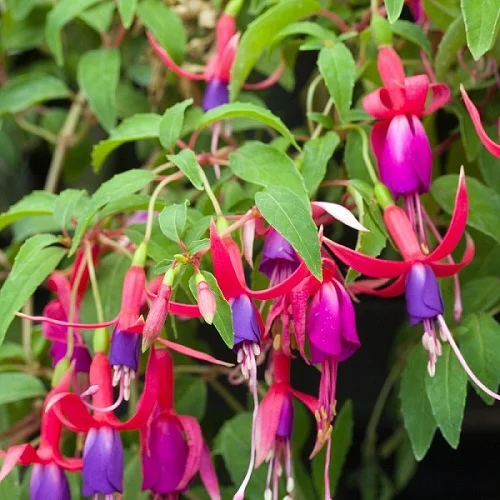
Botanical name: Fuchsia hybrida
Common name: Fuchsia Plant
Origin: South America, Central America, Newzealand
Height: 2-3 ft
The blooms in Fuchsia are showy sepals and petals which may or may not be the same color. They may be single, semi-double, double bells or clustered blooms borne on soft-stemmed bushes.
Fuchsia are some of the popular flowering plants for hanging baskets where the stems and vibrant blooms cascade downwards beautifully.
Fuchsia hybrida bloom in bright indirect light (filtered light), warmth of 15-230C, humidity of 50-55% and consistently moist, rich, well-drained potting soil coupled with fortnightly feeding during the growing season.
Learn more on how to grow and care for Fuchsia Plants
12. Geraniums
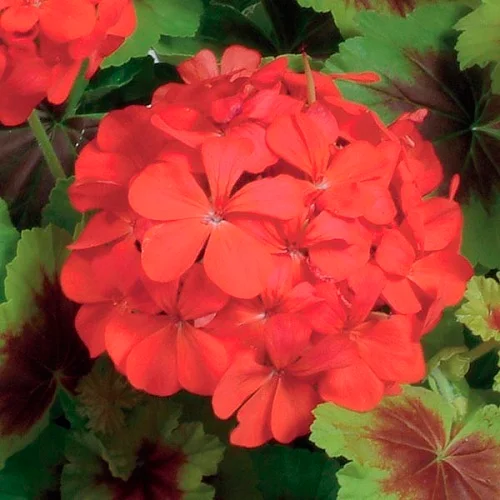
Botanical name: Pelargonium x hortorum
Common names: Geranium
Origin: Hybrid with South African parentage
Height: 1-2 ft
Geraniums are popular flowering plants due to their ease of care, a long flowering period and large colourful blooms which come in white, red, pink, orange and purple.
Pelargonium x hortorum like Pelargonium peltatum are prolific bloomers with magnificent foliage and large, delightful flowers which may be single, semi-double or double.
Pelargonium x hortorum will bloom almost all year-round if kept on a large sunny window at a warmth of 18-270C, humidity of 50-55% and consistently moist, rich, well-drained potting mix coupled with monthly feeding in the growing season.
Learn more on how to grow and care for Geraniums
13. Gerbera Daisy
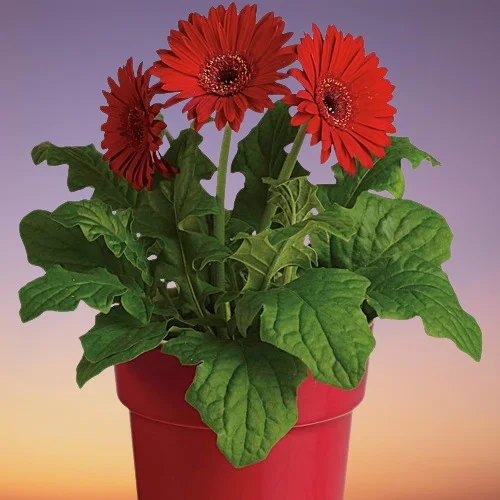
Botanical name: Gerbera jamesonii
Common name: Gerbera Daisy, Barbeton Daisy, Transvaal Daisy
Origin: South Eastern Africa
Height: 2 ft
The flower colors in Gerbera Daisy range from soft pink, white, pale yellow, pink, orange, red and purple. The hybrids are more compact and can produce up to six blooms at a time.
As indicated in the NASA Clean Air Study, Barbeton Daisy is among the best air-purifying plants and gets rid of formaldehyde and benzene from indoor air.
Gerbera jamesonii flourishes in bright light with 6-8 hours of direct sunshine, warmth of 15-250C, humidity of 50-55% and moderately moist, rich, well-drained soil coupled with monthly feeding during the growing season.
Learn more on how to grow and care for Gerbera Daisy
14. Goldfish Plant
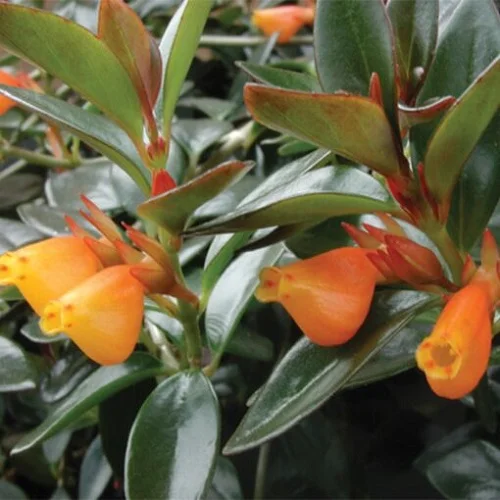
Botanical name: Columnea gloriosa
Common names: Goldfish Plant
Origin: Tropical America and the Caribbean
Height: 3 ft
Goldfish Plant bears trailing stems and abundant yellow or orange-red tubular flowers which look like leaping fish and hence the common name.
Goldfish Plant is among the popular plants for a hanging basket or a pedestal where the trailing stems can be allowed to hang down freely.
Columnea gloriosa requires bright indirect light (filtered light), warmth of 18-260C, humidity of 60-70% and moderately moist, fertile, well-drained potting soil coupled with fortnightly feeding during the growing season.
Learn more on how to grow and care for Goldfish Plant
15. Golden Shrimp Plant
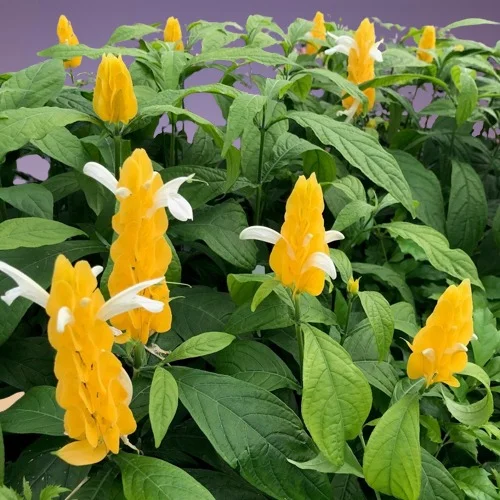
Botanical name: Pachystachys lutea
Common names: Golden Shrimp Plant, Yellow Shrimp Plant, Lollipop Plant, Golden Candle Plant
Origin: Peru
Height: 3-6 ft
Golden Shrimp Plant bears an upright spike made up of bright yellow bracts and short-lived white two-lipped flowers which emerge sequentially. It flowers from spring through summer.
Pachystachys lutea is similar to Beloperone guttata (Mexican Shrimp Plant) which features bright reddish-yellow bracts instead of bright yellow bracts.
Yellow Shrimp Plant thrives in bright light with at least 4-6 hours of sunshine, warmth of 15-280C, humidity of 60-70% and moderately moist, rich, well-drained soil coupled with fortnightly feeding during the growing season.
Learn more on how to grow and care for Golden Shrimp Plant
16. Laceleaf Anthurium
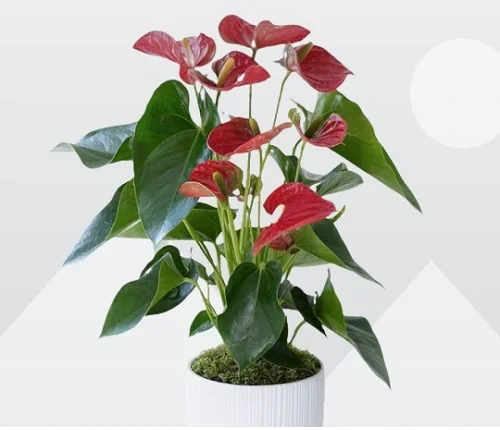
Botanical name: Anthurium andraeanum
Common names: Laceleaf Anthurium, Oilcloth Flower, Painter's Palette, Tailflower
Origin: Columbia, Ecuador
Height: 2-3 ft
Laceleaf Anthurium is one of the popular Anthurium varieties on account of its spectacular blooms and glossy dark-green leaves. With proper care it can last for many years.
Anthurium andraeanum and Anthurium scherzerianum (Flamingo Flower) are popular flowering plants which are often mistaken for each other. The difference between them is in the spadix where Anthurium andraeanum has a straight spadix while Anthurium scherzerianum has a curly one.
Anthurium andraeanum prospers in bright indirect light (dappled light), warmth of 18-270C, humidity of 50-60% and consistently moist, rich, well-drained potting soil coupled with fortnightly feeding in the growing season.
Learn more on how to grow and care for Laceleaf Anthurium
17. Flaming Katy

Botanical name: Kalanchoe blossfeldiana
Common names: Flaming Katy, Christmas Kalanchoe, Florist Kalanchoe, Madagascar Widow's-thrill
Origin: Madagascar
Height: 1-2 ft
Flaming Katy is among the popular succulent plants with reddish leaves in bright light and long lasting flowers which can be induced in any season. The flowers come in red, pink, yellow, and white colors
Florist Kalanchoe and its cousin Kalanchoe uniflora (Trailing Kalanchoe) are prolific bloomers and some of the best flowering plants for a sunny spot.
Kalanchoe blossfeldiana grows best in bright light with 4-6 hours of direct sunshine, warmth of 15-280C, humidity of 50-55% and moderately moist, fertile, well-drained succulents soil coupled with fortnightly feeding during the growing season.
Learn more on how to grow and care for Flaming Katy
18. Madagascar Jasmine

Botanical name: Stephanotis floribunda
Common names: Madagascar Jasmine, Hawaiian Wedding Flower, Bridal Wreath, Clustered Wax Flower, Bridal Veil Vine
Origin: Madagascar
Height: 20 ft
Madagascar Jasmine is a vigorously-growing, climbing, flowering plant with white, waxy, star-shaped, tubular, sweet-scented flowers which are borne on new growth in spring through fall.
On account of its requirement for exposure to some sunshine, Hawaiian Wedding Flower is among the popular sun-loving plants for growing in the home.
Stephanotis floribunda blossoms in bright light with 4-6 hours of direct sunshine, warmth of 20-250C, humidity of 55-65% and consistently moist, rich, well-drained soil coupled with monthly feeding during the growing season.
Learn more on how to grow and care for Madagascar Jasmine
19. Scarlet Star Bromeliads
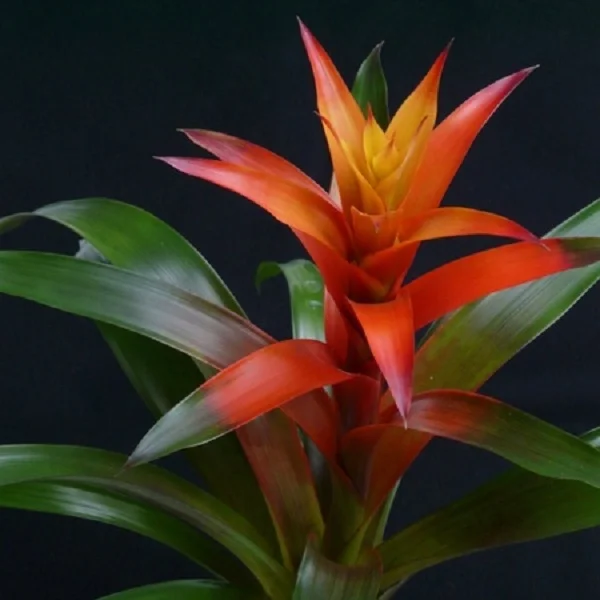
Botanical name: Guzmania
Common names: Scarlet Star Bromeliad
Origin: Florida, The West Indies, southern America, Central America, Mexico, South America
Height: 3 ft
Guzmania Bromeliads are popular Bromeliad varieties grown for the beauty of their bright-red or orange showy flower-heads with a central cluster of small white flowers.
Scarlet Star Bromeliads are typical Bromeliads with leathery, arching leaves and a distinct central 'vase' from which a stout stalk bearing a bold flower-head emerges.
Guzmania Bromeliads grow best in bright indirect light, warmth of 16-260C, humidity of 60-70% and moderately moist, fertile, well-drained orchids soil coupled with regular feeding during the growing season.
Learn more on how to grow and care for Scarlet Star Bromeliads
20. Peace Lily
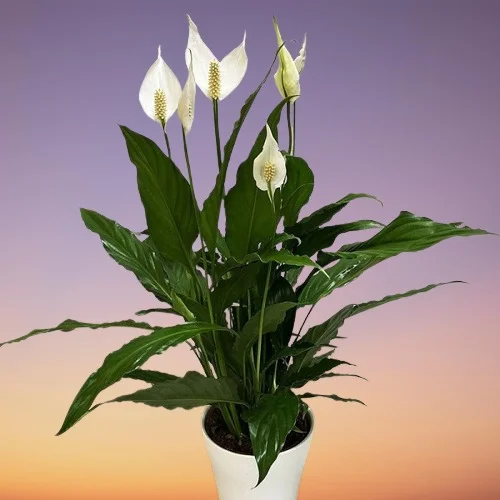
Botanical name: Spathiphyllum wallisii
Common names: Peace Lily, White Sails, Spathe Flower
Origin: Central America, Southeastern Asia
Height: 3 ft
Peace Lily is one of the popular indoor plants on account of its ability to clean indoor air while the dark-green glossy leaves and white blooms will brighten any space.
The bloom in Peace Lily is a spathe which appears pale green as it begins to grow and turns white at it opens. It surrounds a spadix that is densely covered by tiny, white flowers.
Spathiphyllum wallisii prefers bright indirect light (filtered light), warmth of 18-260C, humidity of 50-55% and moderately moist, fertile, well-drained, Peace Lily potting mix coupled with monthly feeding during the growing season.
Learn more on how to grow and care for Peace Lily
21. Chenille Plant
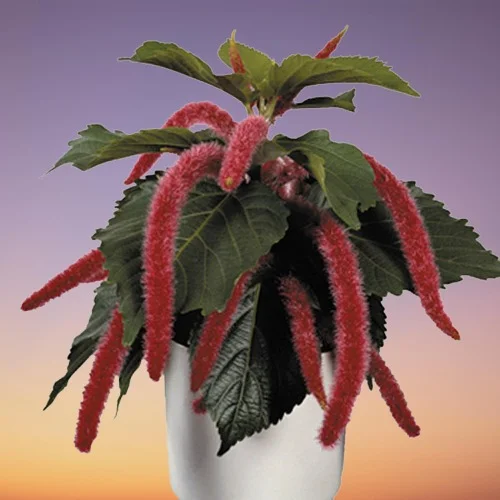
Botanical name: Acalypha hispida
Common names: Chenille Plant, Philippine Medusa, Red Hot Cat Tail, Monkey Tail, Foxtail
Origin: Malesia and Papuasia
Size: 5-8 ft
Chenille Plant is one of the best flowering plants for hanging baskets on account of its magnificient, pendulous, brilliantly colored, furry flowers and large, bright-green, heart-shaped leaves.
Unlike its relative Acalypha wilkesiana (Copperleaf Plant) which bears both male and female flowers on the same plant, Red Hot Cat Tail is dioecious which means that male and female flowers are borne on different plants.
Acalypha hispida blossoms in bright indirect light (filtered light), warmth of 18-280C, humidity of 55-70%, and moderately moist, fertile, well drained potting soil coupled with fortnightly feeding in the growing season.
Learn more on how to grow and care for Chenille Plant (Acalypha hispida)
22. Wax Plant

Botanical name: Hoya carnosa
Common names: Wax Plant, Porcelainflower
Origin: Eastern Asia, Australia
Height: 15 ft
Wax Plant is flowering climber with fleshy leaves and twining stems which can reach 15 feet or more making it perfect for a hanging basket or a trellis.
Hoya carnosa is among the popular Hoya varieties which are grown for their beautiful leaves and large flowerheads made up of waxy, fragrant and star-shaped flowers.
Hoya carnosa thrives in bright light with with 4-6 hours of direct sunlight, warmth of 16-260C, humidity of 50-55% and moderately moist, rich, well-drained hoya potting soil coupled with monthly feeding during the growing season.
Learn more on how to grow and care for Wax Plant
23. Urn Plants
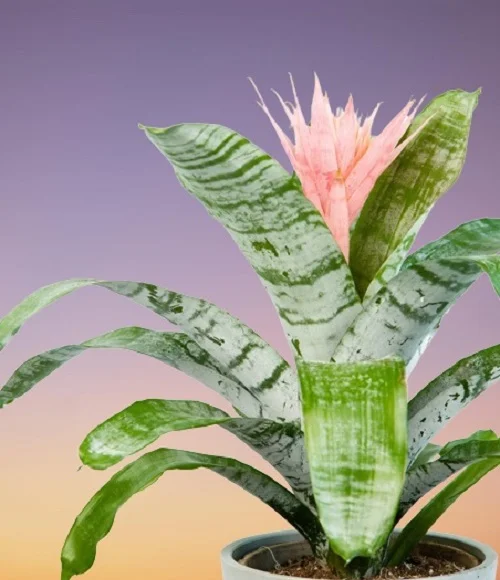
Botanical name: Aechmea
Common names: Urn Plants, Aechmea Bromeliads
Origin: Mexico, South America
Height: 2-3 ft
The bloom in Urn Plants is a display of an upright flowerhead comprising of long-lasting showy bracts. The true flowers are small and short-lived.
Aechmea Bromeliads like Ananas Bromeliads (Ornamental Pineapples) are considered non-toxic to both humans and pets. The plants are safe to grow in the home.
Aechmea Bromeliads grow best in bright indirect light (dappled light), warmth of 15-260C, humidity of 60-70% and consistently moist, fertile, well-drained orchids potting mix coupled with fortnightly feeding during the growing season.
Learn more on how to grow and care for Urn Plants
24. Rose Grape

Botanical name: Medinilla magnifica
Common names: Rose Grape, Showy Medinilla, Philippines Orchid, Pink Lantern
Origin: Philippines
Height: 2 ft
Rose Grape bears spectacular, pendant, rosy-pink flower-heads with showy pink basal bracts and are about 1.5 feet long which hang down beautifully.
Philippines Orchid and Bluecrown Passionflower (Passiflora caerulea) and Trailing Velvet Plant (Ruellia makoyana) are popular flowering plants which can be grown in a hanging basket or on a pedestal where they can display their magnificent flowers and delightful foliage.
Medinilla magnifica thrives in bright indirect light (filterd light), warmth of 16-240C, humidity of 60-70% and moderately moist, fertile, well-drained potting soil coupled with fortnightly feeding in the growing season.
Learn more on how to grow and care for Rose Grape
25. Pink Jasmine
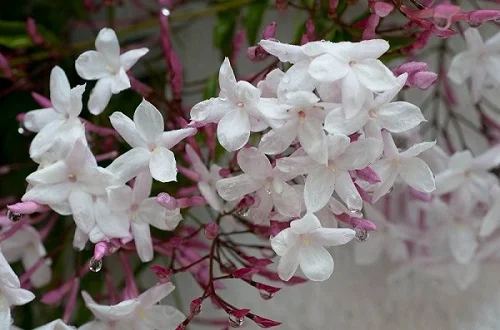
Botanical name: Jasminum polyanthum
Common names: Pink Jasmine, Winter Jasmine, Star Jasmine, French Perfume, Chinese Jasmine, Manyflowered Jasmine
Origin: Southeastern China
Height: 10 ft
Pink Jasmine is one of the easiest to grow Jasmines and is mainly grown for the characteristic fragrance of its flowers and its resistance to pests and diseases.
Winter Jasmine is a popular, vigorously-growing, climbing, flowering plant which bears fragrant flowers in clusters. Like Golden Trumpet (Allamanda cathartica), another flowering plant, it is ideal for a hanging basket or a trellis.
Jasminum polyanthum blossoms in bright light with 4-6 hours of direct sunlight, warmth of 18-240C, humidity of 50-55% and consistently moist, rich, well-drained potting soil coupled with fortnightly feeding during the growing season.
Learn more on how to grow and care for Pink Jasmine
26. Mountain Fire Senecio

Botanical name: Senecio cephalophorus
Common name: Mountain Fire Senecio
Origin: South Africa
Height: 1.5-2 ft
Mountain Fire Senecio is a compact, succulent plant which bears a large head of dark-orange inflorescence borne above the foliage on a long stalk.
Mountain Fire Senecio and Blue Chalksticks Plant (Senecio serpens) are among the best drought-tolerant plants on account of their succulent leaves and stems which store water allowing them to go for considerably long periods without being watered.
Senecio cephalophorus thrives in bright light with 4-6 hours of direct sunshine, warmth of 20-260C, humidity of 50-55% and moderately moist, fertile, free-draining succulents mix coupled with monthly feeding during the growing season.
Learn more on how to grow and care for Mountain Fire Senecio
27. African Lily
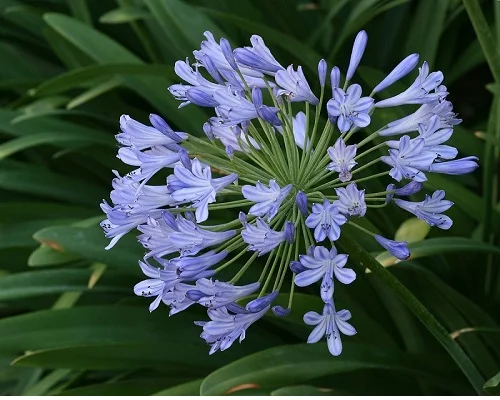
Botanical name: Agapanthus africanus
Common name: African Lily, Lily of the Nile
Origin: South Africa in Cape of Good Hope
Height: 2-3 ft
African Lily bears large round heads of beautiful tubular flowers on long stalks which appear in succession through out the growing season and come in blue, white, pink and violet.
The Lily of the Nile is a fast-growing plant which grows to a height of 2-3 feet and about 2 feet wide. The strap-like leaves are about 1 foot long and the ball-like flower heads are about 3-8 inches in diameter.
Agapanthus africanus blooms in bright light with 4-6 hours of direct sunlight, warmth of 16-270C, humidity of 50-55% and consistently moist, fertile, well-drained soil coupled with fortnightly feeding during the growing season.
Learn more on how to grow and care for African Lily
28. Moth Orchids
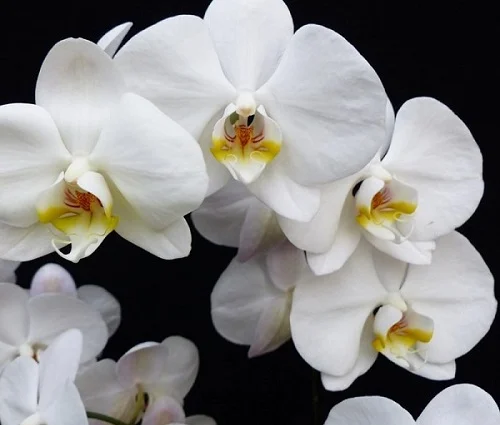
Botanical name: Phalaenopsis
Common name: Moth Orchid, Phals
Origin: Indonesia, Philippines
Height: 1 ft
Moth Orchids also called Phals are some of the popular orchids with flat-faced, fragrant, long-lasting flowers on a stem that branches near the end.
Moth Orchids are monopodial which grow from a single point, they add leaves to the apex each year and the stem grows longer accordingly. They have long-coarse roots and short, leafy stems hidden by overlapping leaf bases; they do not have pseudobulbs.
Phalaenopsis Orchids blossom in bright indirect light, warmth of 16-290C, humidity of 60-70% and moderately moist, fertile, well-aerated orchids potting soil coupled with regular feeding during the growing period.
Learn more on how to grow and care for Moth Orchids
29. Bleeding Glory Vine
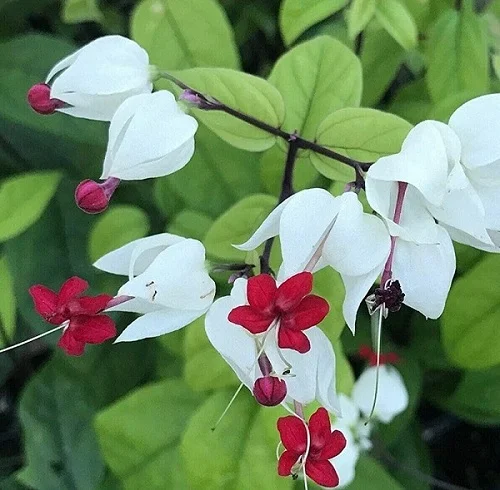
Botanical name: Clerodendrum thomsoniae
Common names: Bleeding Glory Vine, Bleeding Glorybower, Tropical Bleeding Heart, Bagflower, Harlequin Glorybower
Origin: West Africa; Cameroon to Senegal
Height: 6 ft
Bleeding Glory Vine is a perennial climbing plant which bears bell-shaped, lightly scented, two-colored flowers; red and surrounded by white sepals.
The blooms in Bleeding Glorybower are borne in terminal clusters of 8-20 in spring and summer and appear bell-shaped and are lightly scented.
Clerodendrum thomsoniae flourishes in bright indirect light (dappled light), warmth of 16-280C, humidity of 60-70% and consistently moist, rich, well-drained soil coupled with monthly feeding during the growing season.
Learn more on how to grow and care for Bleeding Glory Vine
30. Bigleaf Hydrangea
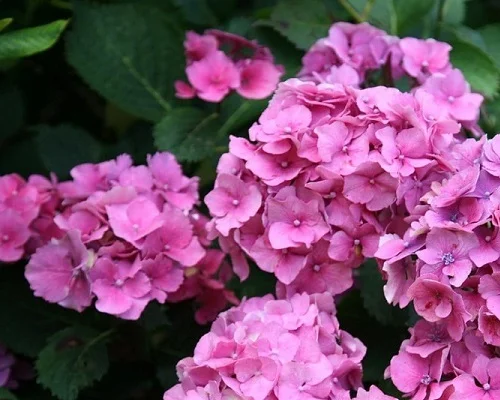
Botanical name: Hydrangea macrophylla
Common names: Bigleaf Hydrangea, Mophead Hydrangea, French Hydrangea, Hortensia, Lacecap Hydrangea
Origin: Japan, from Honshu southwards.
Height: 7 ft
Bigleaf Hydrangea is a spectacular, flowering plant whose blooms can be white, blue, red, pink, light purple or dark purple where the color is affected by the soil PH.
The Mophead Hydrangea is a perennial shrub growing to 7 feet tall by 8 feet broad which bears large globular heads of flowers about 6-8 inches across.
Hydrangea macrophylla grows best in bright indirect light, temperatures of 10-180C, humidity of 50-55% and consistently moist, fertile, well-drained soils coupled with fortnightly feeding during the growing season.
Learn more on how to grow and care for Bigleaf Hydrangea
